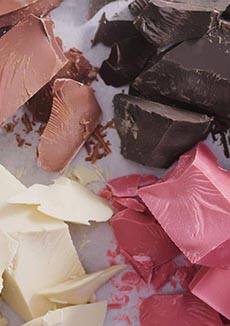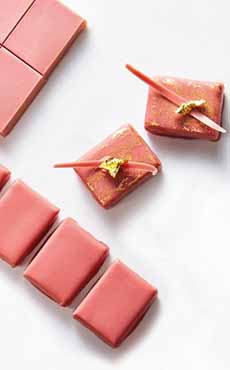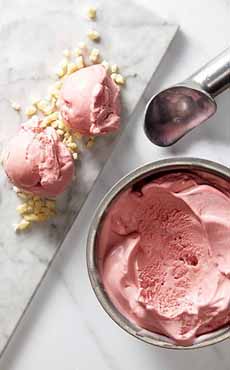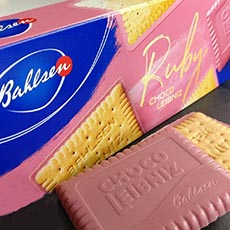TIP OF THE DAY: Ruby Chocolate & Bahlsen’s “Cookies For A Cause”
|
|
Dark, milk and white chocolate have a new sibling: ruby chocolate. The food scientists at Swiss* cacao producer Barry Callebaut created the new chocolate type they call ruby. It’s named for its rosy color (photo #1)—and possibly because many people might think that “pink chocolate” was for kids. To the eye it is a lovely shade of pink (photo #1). On the palate it delivers berry and citrus flavor notes. It’s a bit tart, in a pleasant way. In fact, it has none of the flavors typically associated with chocolate, just the creamy mouthfeel. So people who don’t like dark, milk and white chocolate might like ruby—and vice versa. According to Barry Callebaut, the chocolate is made from a cacao bean they’ve dubbed the ruby cacao bean. The color and flavor of the couverture are all from nature: No flavoring or color is added (sugar is added by whomever is transforming the couverture into a finished chocolate product). The naturally-occurring ruby cacao bean has properties that allow it to be processed into pink, fruity ruby chocolate. Cacao, like wine grapes and other fruits, can be widely affected by their terroir. Ruby cocoa beans grow under particular levels of humidity, sunshine and temperature and can be found in the Côte d’Ivoire, Brazil and Ecuador. The new chocolate arrives some 80 years after white chocolate was introduced to the market by Nestlé, in the 1930s. Ruby chocolate began development in 2004. According to the company: Barry-Callebaut’s process is, of course, proprietary. However, we know that in 2009 the company registered a patent for “cocoa-derived material” from unfermented cocoa beans (or beans fermented for no more than three days) that become red or purple after treating them with an acid (citric acid) and then defatting with petroleum ether.” After harvesting, beans are traditionally washed (“lavado”), then fermented (“fermentado”) for four days. They are then dried in preparation for roasting. Beans that are only washed can have a natural red-pinkish color. Industry speculation is that ruby chocolate is made with unfermented cacao beans that are washed but not fermented. The citric acid that engenders the pink color also provides the slight tart taste [source]. The percent of cacao in ruby chocolate is less than milk chocolate, which as 30% or more cacao‡. Ruby chocolate was first available for sale to consumers in January 2018. It was introduced in a new, premium flavor of Kit Kat bar in Japan and South Korea (Kit Kats are sold there in a wide variety of flavors. The ruby Kit Kat bar was next rolled out in Canada, Germany, the U.K., Australia and New Zealand. And now, it’s in the U.S. The first products we’ve seen so far are: According to Barry-Callebaut, ruby cacao pairs extremely well with rosé Champagne, Belgian Kriek beer, salty caramels and blue cheese. To these, THE NIBBLE adds a fruity red like Beaujolais, dessert wines like demi-sec and sec Champagnes, Port and these dessert wines. Here’s more information from Barry Callebaut. Here’s a great way to try ruby cacao and help support breast cancer (October is Breast Cancer Awareness Month). They’re limited-edition biscuits from Bahlsen, the world’s largest family-run biscuit [cookie] producer in the world, since 1889. The company’s first innovation, in 1891, were the delectable cookies known in the U.S. as Choco Leibniz (Leibniz Keks in Germany): a buttery biscuit on one side, a bar of chocolate on the other. |
|
|
The limited edition, available in September and October, is officially called Choco Leibniz presents Ruby Cacao (photos #4, #5 and #6). A portion of sales benefits PLAY for P.I.N.K., which donates 100% of proceeds to advance the world’s most promising research. “Cookies for a Cause” will be available from September 1st through October 31st, 2019, for $4.99 at select grocers and specialty markets including Cost Plus World Market, Earth Fare, Ingles, Jungle Jim’s, ShopRite and Stop & Shop. *The company is currently based in Zürich, Switzerland. It is a 1996 merger of Belgian chocolate producer Callebaut and French producer Cacao Barry. †Cocoa and cacao are often used interchangeably. “Cocoa” was actually a typo on a ship’s manifest in the 1700s. The Nibble uses cacao to refer to the bean, cocoa to refer to the drink (a.k.a. “drinking chocolate”), and chocolate for “eating chocolate.” ‡Most “newsstand” milk chocolate contains 30% cacao. The higher the percentage of cacao, the more chocolatey the flavor. Artisan producers often produce up to 45% milk chocolate, and products called “dark milk chocolate” can contain up to 70% cacao. Here’s more information.
|
||







